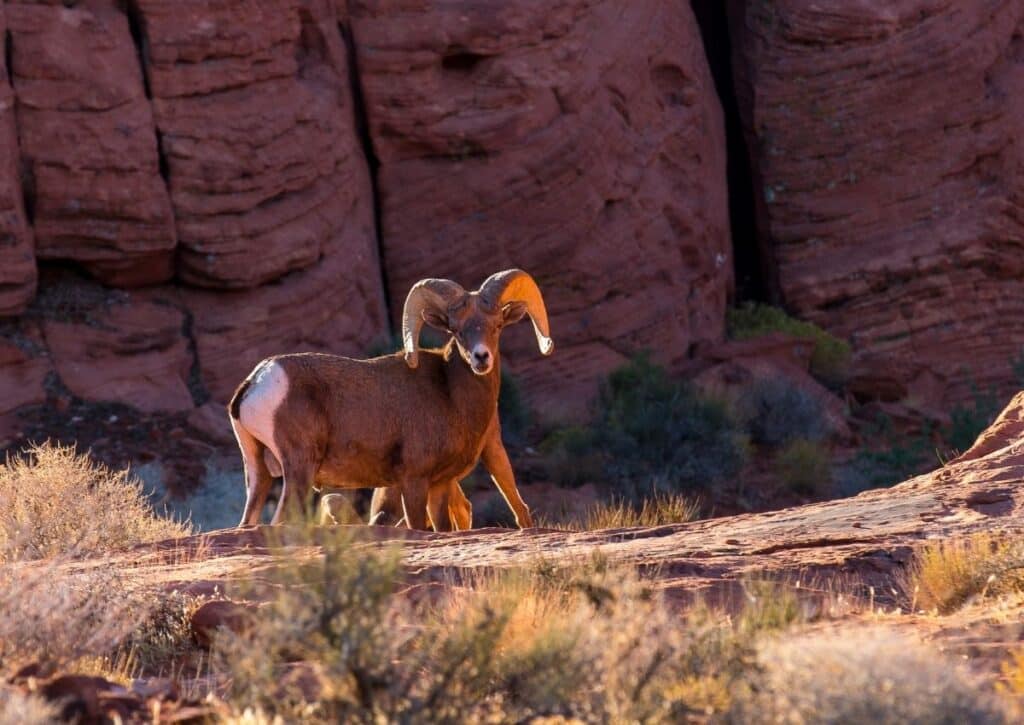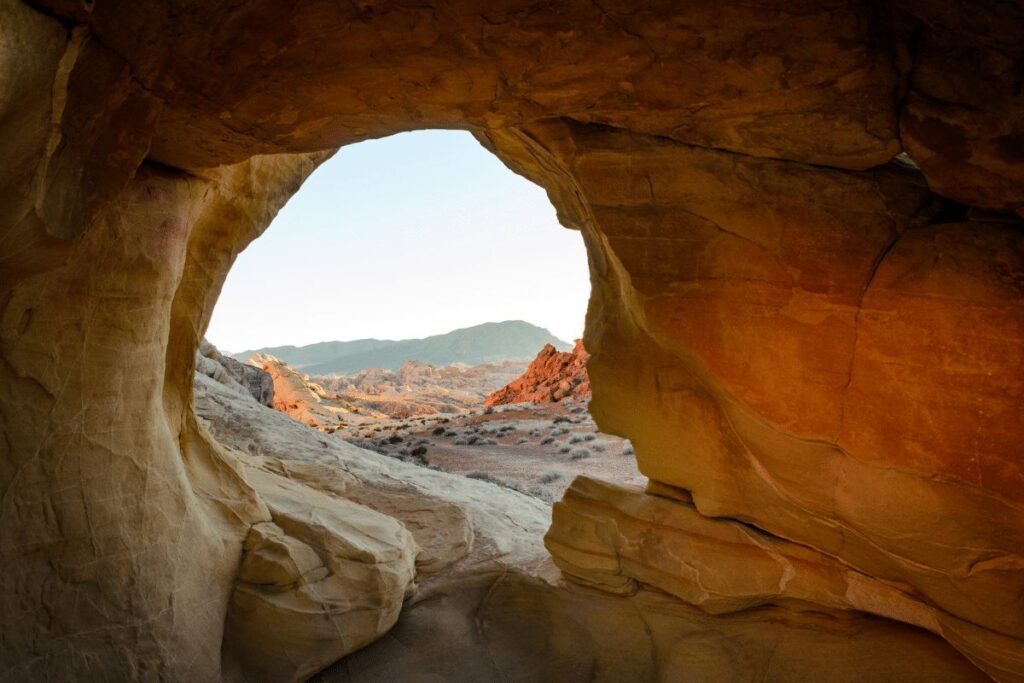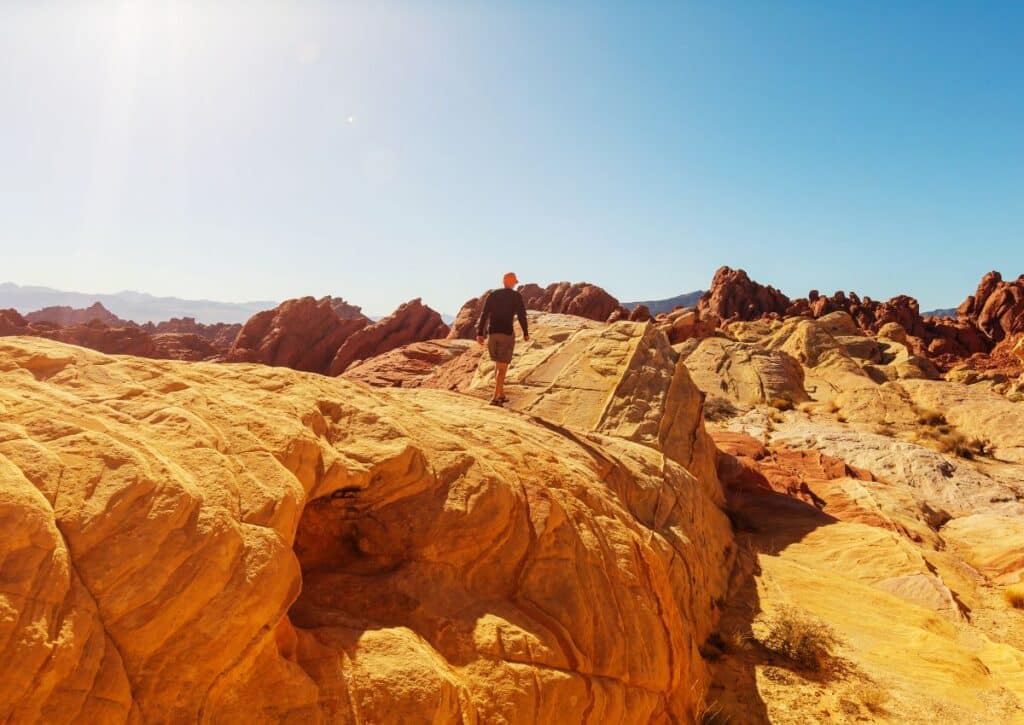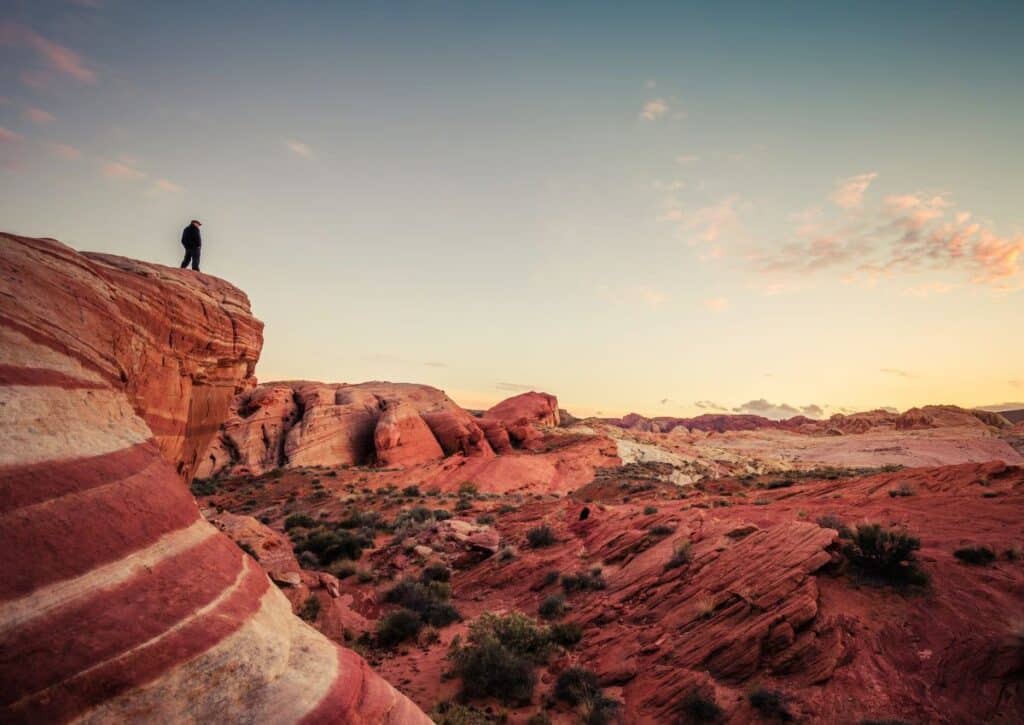Explore the habitat and habits of Desert Bighorn Sheep in Valley of Fire State Park, including spotting tips and trail guides, with expert insights.
Valley of Fire State Park in Nevada is home to the remarkable Desert Bighorn Sheep. These animals have uniquely adapted to thrive in the challenging desert conditions.
Curious about how they do it? In this article, we delve into the intriguing world of these sheep, uncovering their survival tactics and the significance they hold within the park.
Additionally, we’ll shed light on the areas and trails in the Valley of Fire we’ve seen Desert Bighorn Sheep on our multiple hiking trips. Read on to discover more about these resilient inhabitants of the Valley of Fire.
The Desert Bighorn Sheep of Valley of Fire State Park
For visitors looking to explore the wonders of Valley of Fire State Park in Nevada, encountering the Desert Bighorn Sheep is undoubtedly a highlight.
These majestic creatures are a living testament to nature’s ability to adapt and flourish in arid conditions, and understanding them can greatly enrich your experience in the park.
The Desert Bighorn Sheep are well-suited for desert living. Their short, coarse fur, ranging from light brown to beige, allows them to blend seamlessly with the park’s rocky terrains, providing natural camouflage from predators.
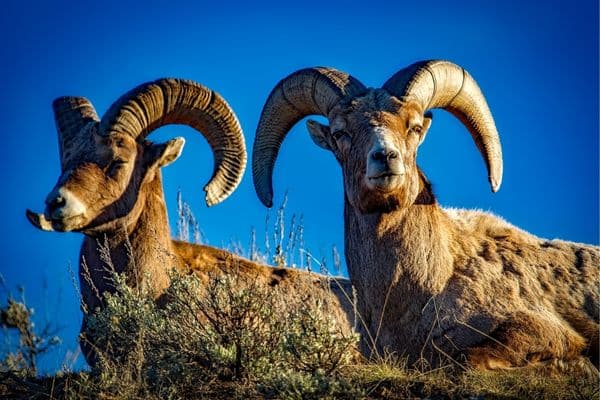
But the standout feature has to be their horns. Large, curled, and imposing, these horns are more than just ornamental; they’re a result of centuries of desert adaptation.
Rams vs. Ewes: Distinguishing between the male (rams) and female (ewes) is relatively straightforward when you know what to look for.
Rams have massive, spiraled horns which can span over two feet in length, often used in head-to-head combat during mating season.
Ewes, in contrast, sport shorter, more straightened horns. While not as grand as their male counterparts, they are equally crucial for the ewes’ defense.
Icon of the Park: While the Valley of Fire offers breathtaking landscapes and a myriad of activities, the Desert Bighorn Sheep stands as its undisputed icon. Their presence in the park provides visitors with a unique opportunity to witness wildlife that has masterfully evolved to thrive in such a challenging environment.
It’s not just about spotting a sheep; it’s about appreciating a species that embodies the spirit of the desert landscape you’ve come to explore.
For those visiting the Valley of Fire, keep your cameras ready and tread lightly. The chance to observe these magnificent creatures in their natural habitat is an experience you won’t want to miss.
Key Adaptations of the Desert Bighorn Sheep
The vast, rugged landscapes of the desert are not for the faint-hearted. Blistering heat, scarce water resources, and treacherous terrains make it a challenging environment for most species.
Yet, the Desert Bighorn Sheep, a symbol of endurance and adaptability, not only survives here but thrives.
Their success in such a harsh environment is due to a series of remarkable physiological and behavioral adaptations that have evolved over millennia. Let’s delve deeper into these adaptations that enable them to master the challenges of the desert.
Water Conservation: Water is the elixir of life, especially in an environment where it’s a rare commodity. One of the most outstanding adaptations of the Desert Bighorn Sheep is their ability to conserve water.
Unlike many mammals, these sheep can go for several days without drinking, relying instead on the moisture they obtain from their food. Their kidneys play a vital role in this, as they have evolved to excrete highly concentrated urine, thus minimizing water loss.
When they do come across a water source, the Desert Bighorn Sheep have the ability to drink quickly and rehydrate. In a matter of minutes, they can consume up to five gallons of water, preparing them for another stretch without a reliable water source.
This rapid hydration capability ensures that they replenish their reserves fast, an essential trait in a terrain where water sources can be unpredictable.
Heat Regulation: In the fierce and unforgiving heat of the desert, the ability to regulate body temperature is paramount. Desert Bighorn Sheep have developed an impressive mechanism to cope with the sweltering heat.
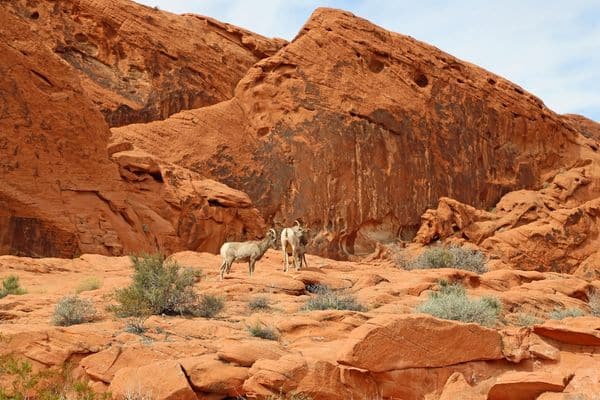
Their body temperature can safely fluctuate several degrees above what many other mammals can tolerate. This range allows them to endure the external heat without immediately needing to dissipate it, thus conserving vital body fluids.
Furthermore, these sheep are crepuscular, meaning they’re most active during the cooler dawn and dusk hours. During the peak heat of midday, they often seek shade or sheltered spots, minimizing their exposure to the direct sun and reducing their need for water.
Hoof Design: The Valley of Fire, with its rugged and uneven terrains, can be a treacherous place to navigate. But the Desert Bighorn Sheep move through this environment with an agility and sure-footedness that’s nothing short of awe-inspiring. Central to this agility is the design of their hooves.
The hooves of the Desert Bighorn Sheep are specialized for climbing and stability. Their concave elastic pads provide a grip that’s well-suited for the rocky surfaces prevalent in the Valley of Fire.
This design, combined with their strong leg muscles, enables them to ascend steep cliffs and traverse narrow ledges with ease, often to escape predators or to access scarce vegetation.
The Desert Bighorn Sheep’s survival in the Valley of Fire is not a mere stroke of luck or a testament to their sheer will. It’s a combination of evolutionary adaptations tailored to meet the challenges of a desert environment head-on.
From conserving water to efficiently managing heat and mastering the rocky terrains, these sheep are a remarkable example of nature’s ingenuity. For visitors to the Valley of Fire, understanding these adaptations offers a richer and more profound appreciation of these iconic desert dwellers.
Wilderness Areas in Valley of Fire Where We’ve Seen Bighorn Sheep
The Valley of Fire State Park, with its radiant red sandstone formations and a history spanning over 150 million years, offers more than just a visual spectacle. It’s also a sanctuary for wildlife, most notably the Desert Bighorn Sheep.
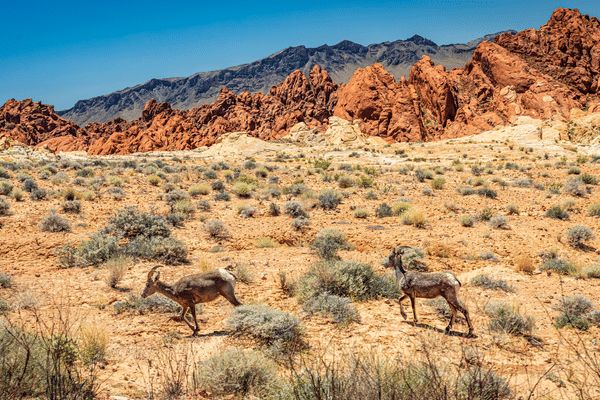
While these magnificent creatures can sometimes be elusive, there are specific wilderness areas within the park where one stands a good chance of spotting them. Here’s a guide to these regions:
- White Domes Area: A popular spot among visitors, the White Domes are characterized by vibrant sandstone formations. The varied terrain, from its valleys to the higher rocky outcrops, is a favored grazing spot for the Bighorn Sheep. Especially during the cooler parts of the day, they can often be seen gracefully navigating the rocky terrains.
- Atlatl Rock and Arch Rock Campgrounds: Both these areas offer not just camping opportunities but also the chance to spot Desert Bighorn Sheep. They often gravitate towards these regions for the vegetation, and the rocky terrain provides them with a strategic advantage against potential predators.
- Mouse’s Tank Trail: This trail, named after a renegade Native American who used the area as a hideout in the 1890s, is a relatively short hike leading to a natural basin where water collects. The availability of water, even if seasonal, attracts the Bighorn Sheep, making it one of the places within the park where you could spot them.
- Rainbow Vista: As the name suggests, Rainbow Vista offers a panoramic view of multicolored sandstones. The vast expanses and the high vantage points are frequented by the Bighorn Sheep, especially during the early mornings and late afternoons.
- Petrified Logs Loop: A less frequented spot, this area is renowned for its petrified trees. The relative seclusion means it’s a peaceful grazing spot for the Desert Bighorn Sheep, and those who venture here stand a good chance of witnessing them in a more serene environment.
For the best chances of spotting these majestic creatures, visitors are advised to:
- Visit during cooler months: The Bighorn Sheep are more active when temperatures are milder.
- Dawn and Dusk: These are their most active periods, offering the best opportunity for sightings.
- Stay silent and maintain distance: To ensure that the animals aren’t startled and for personal safety.
Lastly, while the thrill of spotting a Desert Bighorn Sheep in its natural habitat is unparalleled, it’s crucial to remember that they are wild animals. It’s essential to observe them from a distance and ensure that we don’t disturb their natural behavior.
The Valley of Fire offers a rare glimpse into the world of these desert-adapted creatures, and it’s a privilege that comes with the responsibility of respect and conservation.
Trails We’ve Seen Desert Bighorn Sheep in the Valley of Fire
The Valley of Fire State Park offers a labyrinth of trails, each winding through the park’s iconic red sandstone formations and offering hikers a chance to witness the desert’s unique biodiversity. Among the park’s most elusive and sought-after inhabitants is the Desert Bighorn Sheep.
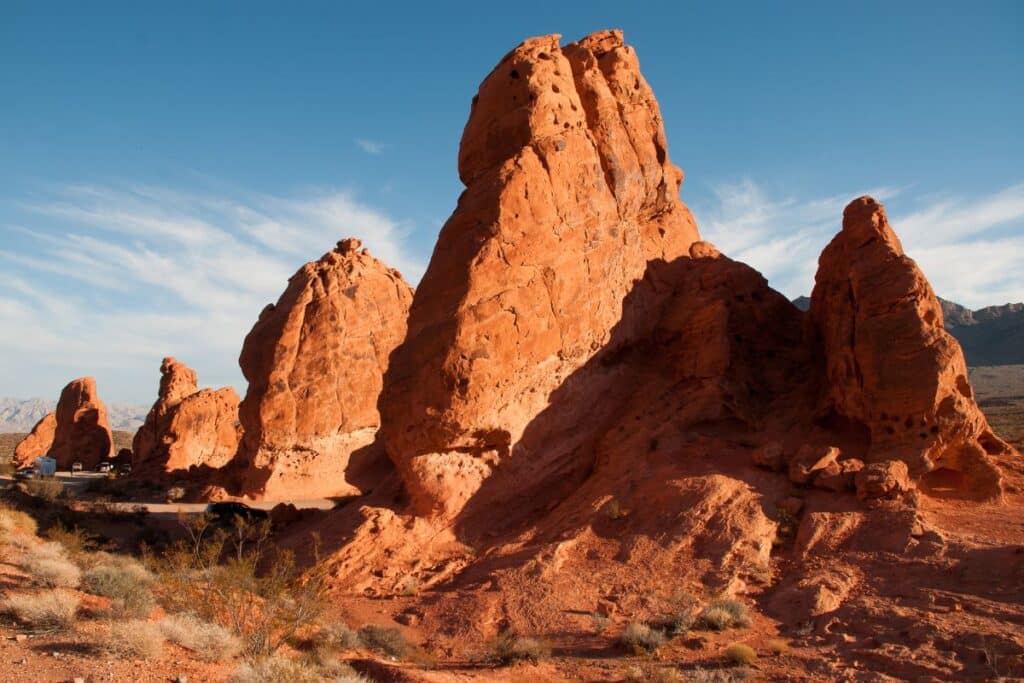
While they can be a challenge to spot, certain trails have garnered a reputation for Bighorn Sheep sightings. If you’re keen on encountering these magnificent creatures during your hike, consider exploring the following trails:
- Mouse’s Tank Trail: A relatively short and easy trail, Mouse’s Tank takes hikers through a canyon to a natural basin, often containing water. The availability of this precious resource in the desert environment makes it a frequented spot for Bighorn Sheep, especially during the early morning and late afternoon hours.
- White Domes Loop Trail: Spanning just over a mile, this trail offers a diverse range of terrains and stunning views of multi-colored sandstone formations. The varied landscape provides ample grazing and resting spots for the Bighorn Sheep, making it a popular trail for potential sightings.
- Petroglyph Canyon Trail: Leading to the famous “Fire Wave,” this trail is not only renowned for its ancient petroglyphs but also for its Bighorn Sheep encounters. The combination of accessible vegetation and elevated lookout points makes it an attractive region for these creatures.
- Rainbow Vista Trail: As a relatively short trail, Rainbow Vista provides panoramic views of the Valley of Fire’s colorful sandstone landscape. The high vantage points and open spaces are ideal for spotting Bighorn Sheep, especially during the cooler hours of the day.
- Fire Wave Trail: While this trail is famed for the iconic Fire Wave rock formation, it’s also a good bet for Bighorn Sheep sightings. The terrain here offers them both grazing opportunities and quick escape routes, given the varied elevation levels.
Tips for Spotting Bighorn Sheep:
- Timing is Crucial: Early mornings and late afternoons, especially during cooler months, are prime times. Bighorn Sheep are crepuscular, meaning they are most active during these hours.
- Tread Lightly: Moving quietly and avoiding loud noises increases your chances of spotting wildlife without disturbing them.
- Use Binoculars: These can help you spot Bighorn Sheep from a distance without approaching them and potentially scaring them away.
- Respect Their Space: Always remember, these are wild animals. For their safety and yours, it’s essential to maintain a respectful distance and avoid approaching them.
The trails of Valley of Fire State Park not only offer an immersive experience into the beauty of the Mojave Desert but also a chance to witness its incredible wildlife.
As you lace up your hiking boots and head into the park, keep an eye out for the Desert Bighorn Sheep – they’re a testament to the desert’s enduring spirit and a highlight of any visit to the Valley of Fire.
Best Times and Tips for Spotting Bighorn Sheep in Valley of Fire State Park
The Desert Bighorn Sheep, with their robust stature and iconic curved horns, are one of the many wonders that call the Valley of Fire State Park home. While spotting these elusive creatures is a delightful experience, knowing the best times and following some essential guidelines can significantly enhance your chances.
Best Times for Sightings:
- Cooler Months: Bighorn Sheep are more active during the cooler months, making fall, winter, and early spring prime times for potential sightings. The scorching summer heat tends to push them to higher elevations or hidden resting spots during the day.
- Early Morning and Late Afternoon: Bighorn Sheep are crepuscular animals, meaning they’re most active during the dawn and dusk hours. The early morning and late afternoon provide cooler temperatures, making these times ideal for the sheep to graze and roam. Visiting the park during these hours increases your chances of catching a glimpse.
Tips and Safe Practices:
- Maintain a Respectful Distance: While it might be tempting to approach these magnificent creatures for a closer look or a perfect photograph, it’s crucial to remember that they are wild animals. For your safety and theirs, always keep a safe distance. Using binoculars or a zoom lens is a great way to get a closer view without physically approaching.
- Avoid Loud Noises and Sudden Movements: Moving quietly and refraining from making loud noises will ensure you don’t startle the sheep. The more unobtrusive you are, the longer and clearer view you’ll likely have of them.
- Tread Lightly and Stay on Designated Trails: Sticking to the designated trails not only helps protect the park’s delicate ecosystem but also ensures that the Bighorn Sheep and other wildlife aren’t unduly disturbed in their natural habitats.
- Be Patient: Nature operates on its own timeline. Sometimes, patience is rewarded with an unforgettable sight. Settle down, relax, and let nature come to you.
- Educate Yourself: Familiarize yourself with the characteristics and behavior of the Desert Bighorn Sheep. Understanding their habits and preferred habitats can enhance your chances of spotting them.
- Leave No Trace: Always remember to leave no trace. This means packing out whatever you bring in and ensuring that the park remains a safe and welcoming habitat for the Bighorn Sheep and other wildlife.
While the Valley of Fire State Park offers a diverse range of attractions, the possibility of spotting a Desert Bighorn Sheep in its natural habitat is a unique and rewarding experience. With the right timing, a touch of patience, and adherence to safe practices, your visit can become a cherished memory.
Conclusion
Valley of Fire State Park is renowned for its striking landscapes and ancient petroglyphs, but the presence of the Desert Bighorn Sheep adds a special allure to its vast expanse.
Throughout the park, specific trails like Mouse’s Tank, White Domes Loop, Petroglyph Canyon, Rainbow Vista, and Fire Wave have become notable spots where visitors might catch a glimpse of these remarkable animals.
To maximize your chances, timing your visit during cooler months and the early morning or late afternoon hours can be beneficial. Remember to always prioritize safety, for both yourself and the wildlife, by maintaining a distance and minimizing disturbances.
All in all, Valley of Fire offers a unique opportunity to see these majestic creatures in their natural habitat—a truly unforgettable experience for any visitor.

